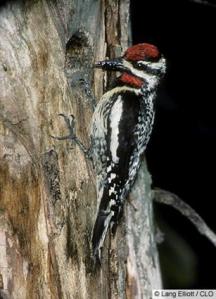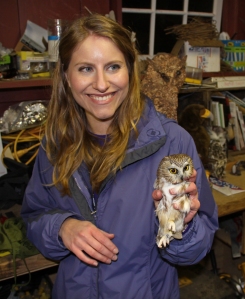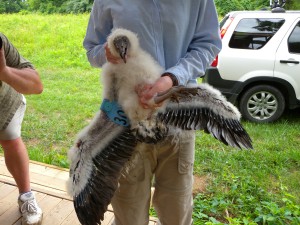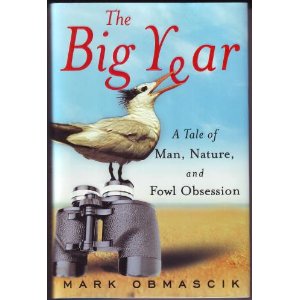
“These were, perhaps, the original poetry…
…in tune with the lift and fall of the seasons,
returning from nowhere,
or from an unknown terrain
which must consequently exist….
…They needed, for no obvious reason, two worlds
in which to feed and breed,
so they needed a capacity for sustained flight,
a fine orientation,
an ability to sleep on the wing
an instinct for form and its rhythms
as each took its turn to cut the wind.”
-Adapted from “First Poetry”, by Moya Cannon, a lovely Irish poet who visited our Rushton banding station this year.

Well folks, it’s about that time…time to admit that the thrilling movement of fall songbird migrants is coming to a close as Old Man Winter looms closer. Last week, our nets produced very few birds (around 30 each day), the majority of species being White-throated Sparrows and Dark-eyed Juncos here to stay for the winter. We also banded many year-round residents like Blue Jays, Northern Cardinals, Carolina Chickadees, and Tufted Titmice. As usual, these classics were crowd-pleasers, especially for the 15 Girl Scouts who came out to Rushton Woods Preserve last Tuesday to learn about birds and earn their honorary Wildlife Badges! The 4th grade girls eagerly learned how to use binoculars, practiced identifying birds by sight and sound, studied the intricate structure of bird feathers, and kept nature journals of their avian field sketches. They were quite the little naturalists!
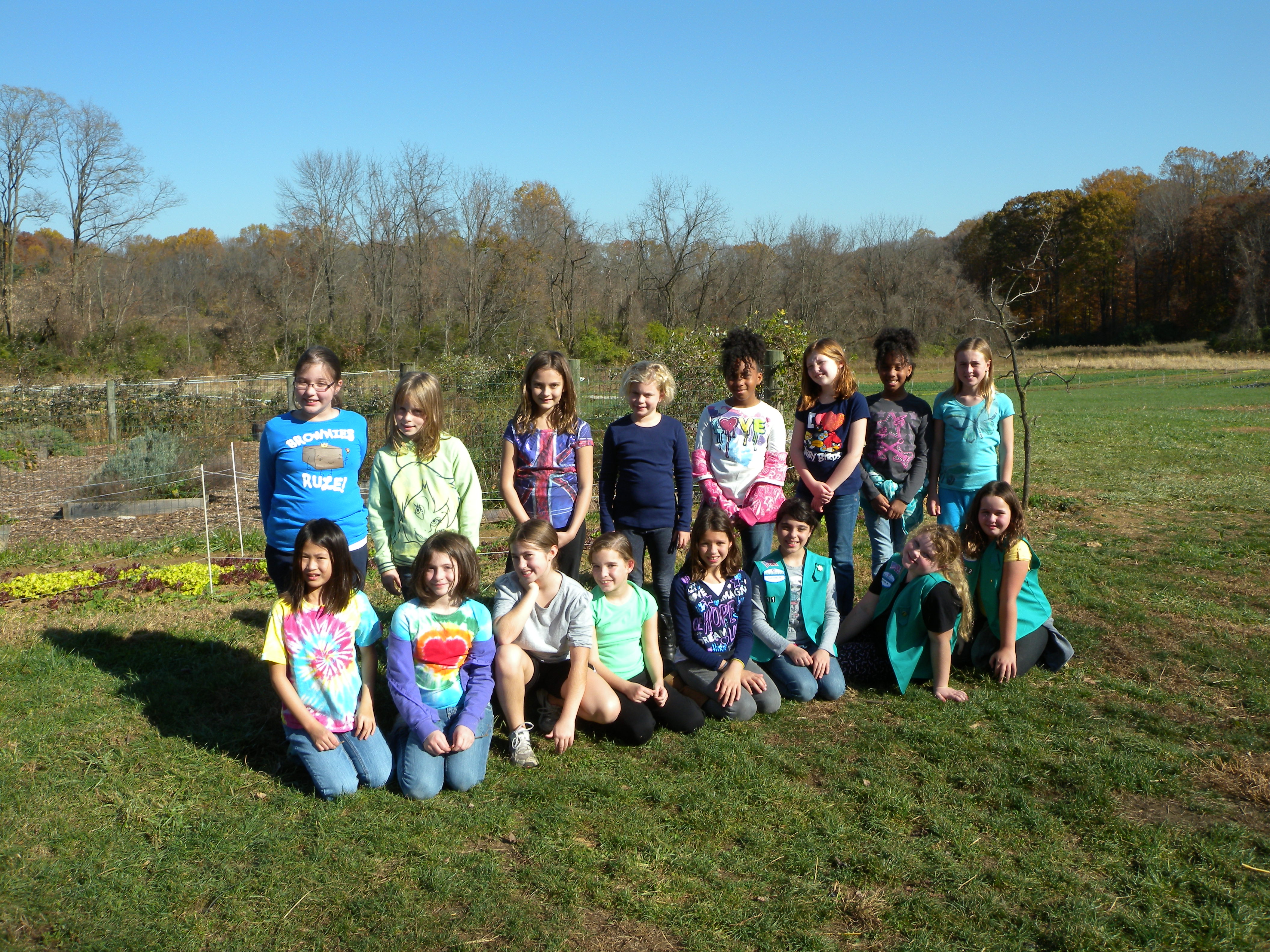

Of most interest last week, in terms of the songbird catch, were a lovely Fox Sparrow and a dashing Red-bellied Woodpecker. The Red-bellied Woodpecker was “nothing special to us”, but our guest bird bander, Emily Thomas, from the Allegheny National Forest of PA was absolutely ecstatic when she heard he was in the net! She sprinted to the net so fast, she said she pulled a muscle! The Red-bellied was one of the few birds she had not seen in the hand in her 7 years of banding because they are not common farther north and in higher elevations, like the Appalachian Mountains. Click here to see the range of our Red-bellied Woodpecker. Never take our common beauties for granted; what is common to us might be extraordinary for someone else! I, myself, remember longing for the familiar Northern Cardinals when I was bird banding in the Pacific Northwest two summers ago.

Emily Thomas was visiting our neck of the woods to speak at The Delaware Valley Ornithological Club (DVOC) and The Birding Club of Delaware County (BCDC) about her interesting graduate research on the effects of oil and gas development on songbird habitat and communities. By the way, both of these prestigious bird clubs are welcoming communities in which to become involved if you are an avid birder, want to cultivate your beginner birding skills or want to make new birding buddies! Both clubs hold interesting birding field trips and have monthly meetings and frequent distinguished speakers.

In a nut shell, what Emily found from her research is that the habitat fragmentation in the Allegheny National Forest from Devonian shale shallow wells actually increases bird species richness (the number of different species). This is because forest clearings from well pads and service roads allow more understory and small-gap loving species (like Indigo Buntings and Cedar Waxwings, respectively) to move in alongside some of the remaining closed canopy nesters (like Blackburnian Warblers) that were there before. However, such fragmentation does result in the loss of some specialist species (ie. closed canopy nesters like Magnolia Warblers) that are unique to that Northern hardwood habitat. A lot of the new species that move in after oil and gas development are generalists like American Robins. In the end, Emily projected her Devonian shale conclusions on Marcellus shale, predicting that the effects of Marcellus fragmentation will actually be less because one deep Marcellus shale well pad can access resources that would require many shallow Devonian pads. However, the habitat footprint for a given Marcellus well pad will be larger than that of any individual shallow Devonian well. It’s all very complicated! For more information on oil and gas development in PA go to http://extension.psu.edu/naturalgas or http://www.dep.state.pa.us/dep/deputate/minres/oilgas/oilgas.htm .

Did you know that baby ticks are out and about? I didn’t even know what a baby tick looked like until last week when we saw little orange bumps on some of our birds, around their eyes and in their ears! Since we did not get a picture of the ticks, go to Hilton Pond’s website and scroll down for a nice (or not so nice!) view of a cluster of ticks under a jay’s eye. We found these exact same clusters on our Blue Jay’s eye as well as in the ear of other species like White-throated Sparrows. Apparentl, they are called seed ticks and will go through several more stages of development before reaching maturity. Yuck!

As for the Northern Saw-whet Owls (NSWO), we are getting shut out left and right. Last year, we banded a total of 24 nights for 91 NSWO. This past Saturday (11/12) was our 24th night this year, and we’re still at only 34 NSWO plus 2 Eastern Screech Owls. As of November 10th, Scott Weidensaul was at 86 owls across his 3 sites (compared to 336 last year to date), which is well below his 10-year average for the date of 187. All of these warm, moonlit nights with South winds are not great for Saw-whet movement. Other owl banding stations, like the Ned Smith Center for Nature and Art, find this trend to be true as well; north winds generate more southbound owl movement. In fact, some other owl banders have been speculating that the role of wind direction in local movements of these tiny owls is significant enough to conclude that they are not a truly migratory species, but rather a somewhat nomadic species with opportunistic migration. It’s never black and white in nature, which is what makes banding so interesting and exciting!

On a related note, the big news last week was our nomad number 0904-08744, which found one of Scott Weidensaul’s (famous author and naturalist) nets at Hidden Valley on November 6 after having been banded by us at Rushton on Halloween. I guess Scott’s Valley isn’t so hidden after all! The Saw-whet Owl was a Hatching Year female (born this summer). This recapture shows that she wandered about 60 miles Northwest to Hidden Valley from Rushton in 6 nights. This same northbound wandering during migration occured last year when another Saw-whet we banded on November 9 was captured 5 nights later, on November 14th, at another one of Scott Weidensaul’s owl banding stations called Small Valley (in the same general vicinity of Hidden Valley). That’s two documented cases of northward wanderings at the tail end of “southbound migration”! This record is also remarkable because Scott encouraged the creation of our owl banding station when Lisa Kiziuk volunteered at Hidden Valley in the 2009 season. Talk about a full circle! Check out the Ned Smith Center’s Owl Research page for more information on Saw-whet Owl research.

While we are on the topic of Scott Weidensaul’s research, did you know that you should be keeping at least one hummer feeder filled and available at least through Thanksgiving? If you’ve put away your feeder already, consider putting it back up and you might get a western vagrant! Scott is one of only about 200 hummingbird banders in the country studying newly evolving migration routes of western hummingbirds.

Traditionally, only the Ruby-throated Hummingbird was found east of the Great Plains, departing in September and wintering in the tropics. However, in recent years, almost a dozen species of western hummingbirds have been showing up in the East and Southeast in autumn and winter (including Eastern PA!). Hummingbird banders studying this emerging phenomenon are finding that most of these vagabonds are Rufous Hummers that breed in the Rockies, Alaska, and the Pacific Northwest and typically winter in Mexico. However, changes in the landscape coupled with the warmer winters of the past century have made the east hospitable; those that survive and return to breeding grounds are passing on these “vagrant” genes that were once unfavorable, resulting in this rapid evolution of a new migratory route and wintering area for these birds.
Most homeowners take down their feeders when the last Rubys leave in September, but these Westerners don’t appear until October, November, or even December. Put that feeder back up if you want a chance at an early little Christmas gift wrapped in iridescent feathers! After Oct 15th, you should contact Scott Weidensaul scottweidensaul@verizon.net if you are sure you have an overwintering western hummingbird. He or a fellow bander will come to your home, capture and band the bird, and release it to continue migration. The results can be spectacular! For example, in January 2010 a Rufous was banded in Tallahassee, FL and was recaptured 6 months later in Chenega Bay, Alaska! This information is vital to understanding how these migration routes are evolving.

Most people find it astonishing that hummingbirds can survive cold winter weather. Western hummers are actually very hardy because they are accustomed to nesting near timber line at high elevations where they can tolerate sub-zero temperatures if need be. These amazing birds can go into deep hibernation-like torpor on cold nights (rubys can only do this to a small extent) during which their body temperature is reduced from 102 F to just 54 F! As for finding enough to eat in cold weather, hummers can find dormant insects and spiders or cold weather active midges. The birds have also been known to drink tree sap from sapsucker wells! Visit Scott’s website to learn more about this fascinating western hummingbird research.

Schedule for the Rest of the Banding Season: Songbird banding is closed for the season, and this Friday and Saturday will be our next owl banding nights. As always, please sign up with Lisa Kiziuk, lkr@wctrust.org, to reserve an owl banding spot! We have not had a good night since November 5th, when we got 7 owls. Since then, we have only been getting one, two, or no owls each night. We’ve also been getting the same owls that we banded several nights before, like Feisty 54. We captured Feisty 54 four times so far this season: first on November 2 and twice in one night on November 11! This ferocious older female may still be haunting Rushton because, although we aren’t catching any owls these nights, we keep hearing Saw-whet calls that we suspect are coming from Feisty 54. Maybe she scared everyone else away! In any case, we are hoping for a few more owls before we shut down for the season (many northern stations have already closed). Even if we don’t get any new owls for audiences this weekend, there is a good chance of recapturing good old Feisty 54! I think she is starting to enjoy the attention. And I’ve also noticed that the human camaraderie is at its best on owl-less nights.
Never a dull moment here in the woods,
~Blake
P.S. The last PA Young Birder meeting on November 4th was a big success… with over 50 kids of all ages and no owls! Luckily, there were so many other fun activities going on (owl art, campfire and s’mores, night hikes, owl seek and find, and owl slideshows) that I don’t think the kids remembered that we were even trying to catch owls!
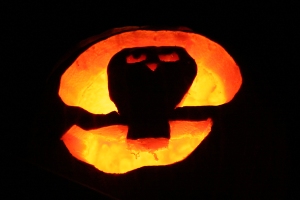
The next PA Young Birder Meeting, “My Nest is Best,” is this Saturday November 19 from 9:30-11am at Rushton Woods Preserve. The Jr. Birders (ages 8-12) will learn about bird architecture and the many different types of nests that birds construct in various habitats. The children will assist with nest box installation for the Trust and will hunt for real cavities used by birds in the woods of Rushton. Please RSVP to Lisa Kiziuk, lkr@wctrust.org.





